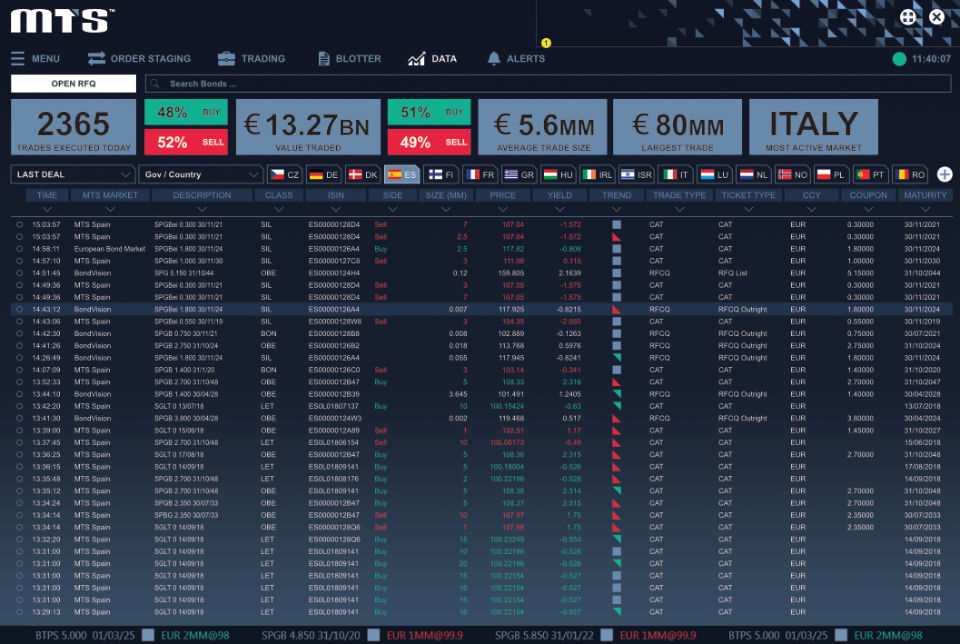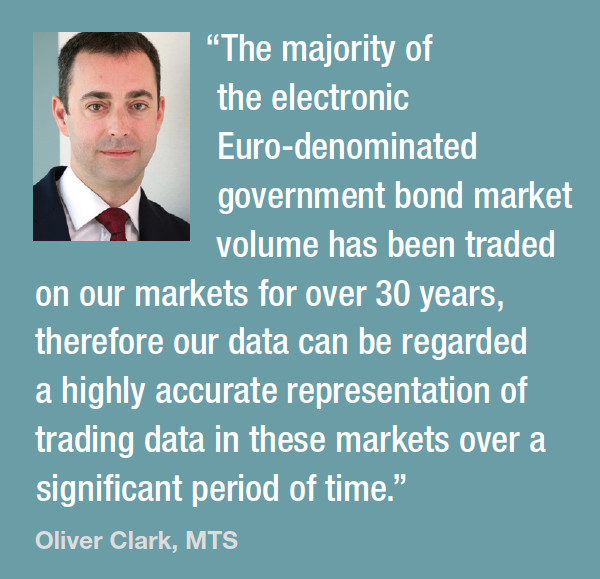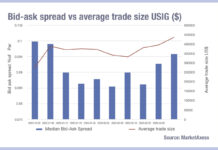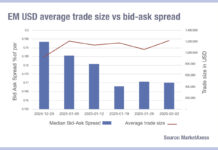
By Oliver Clark, Head of Product Development, MTS.
The role of the fixed income trader is radically and rapidly transforming. As more workflow shifts onto electronic platforms, computers and algorithms play an increasingly crucial role in supporting traders by automating a vast range of processes. Automation creates opportunities to improve productivity by reducing inefficiencies and boosting performance throughout the whole lifecycle of a trade.
In this paper, we will discuss how automation can benefit the trader at each point in the trade lifecycle and explore some of the tools and services MTS provides to support your automation efforts.
To make decisions, you need data
Even before the trade is placed, automation can play an important role in helping traders identify the right trade at the right moment. From providing quantitative analysis to support human traders, right through to automated trading, algorithms have an increasingly important role to play when it comes to selecting the trades to make.
While automated trading technologies have been a mainstay of the equities market for some time, the fixed income market is now rapidly following suit as more trades are conducted electronically. The emergence of new technologies such as machine learning and wider availability of application programming interfaces (APIs) for trading have enabled bond traders and their algorithms to take automated electronic trading to the next level.
These algorithms can be incredibly powerful when fed with the right data. However, algorithms processing incomplete data sets can not only be ineffective, they are potentially dangerous.
While a human trader can use intuition to guide themselves through a period of unexpected market volatility and avoid the worst of a crisis, algorithms can only refer to the information that they already have. If an algorithm has not been back tested on a long enough range of data, including periods of volatility, the algorithm can make inaccurate decisions which could be extremely costly.

The best data drives the best results
Comprehensive historical data is, therefore, a prerequisite for effective pre-trade automation technology. This data needs to be available for a substantive time period and be thoroughly cleaned if it is to facilitate the building and testing of algorithms to be used to feed automated trading features on electronic platforms.
MTS provides a broad range of automation solutions to match a firm’s specific level of sophistication, but data is at the heart of each of our offerings. While we are often most closely associated with the government bond market, our data spans asset classes and is also available for repo products and US credit too.
This real-time order book data is sourced directly from the 18 interdealer trading venues we operate, which support trading in over 2,500 different bonds. We are the only player in the fixed income space that integrates interdealer market data directly into a dealer-to-client trading platform.
Our data provides actual traded prices or executable prices – never indicative – that are live on our platforms. It is sourced from a diverse trading community which generates 30 million daily average orders per day. The majority of the electronic Euro-denominated government bond market volume has been traded on our markets for over 30 years, therefore our data can be regarded a highly accurate representation of trading data in these markets over a significant period of time.

Data is also crucial to our offering in the corporate bond and emerging market debt spaces, where our MTS BondsPro platforms offers US and UK traders an innovative all-to-all model that boosts liquidity by enabling anyone to act as either price provider or price taker.
Pre-trade data on the platform is derived from over 650 buy-side and sell-side market participants and is distributed in real-time. Users see the full depth of market before they execute a trade, which is a key differentiator for our platform. Market participants can access limit order book prices every day on over 17,000 corporate bonds in USD and other currencies.
This comprehensive and detailed data can be used to rigorously back-test quantitative algorithmic strategies and even to train advanced machine learning tools.
Frictionless trading with APIs and auto-execution
Automating the fixed income workflow begins with pre-trade data. Feeding APIs and innovative new automation tools with inaccurate or incomplete data is inherently risky. Put simply, bad data in equals bad data out. Take this risk out of the equation by relying on a trusted data provider and market facilitator to lay the foundation for automating your fixed income business.
Once the algorithm, or the trader with the aid of automated tools, has selected their trade, it is time for trade execution. Here automated tools also play a pivotal role. Many buy-side fixed income desks break their trade down into ‘low touch’ straightforward trades and more complex ‘high touch’ trades.
These low touch trades can be quite manually intensive to perform and yet are often relatively routine. This makes them a prime candidate for automation. This can free traders up to spend their time handling more complex high touch trades and make trades more productive.
To support this, MTS’s newly redesigned BondVision trading platform provides an automated execution facility which allows traders to upload trades directly from their OMS and have BondVision automatically handle the RFQ and execution process based on the trader’s pre-set parameters in the rules engine.
More than 20 auto execution parameters can be configured directly from the new BondVision trading platform, giving traders a maximum level of control whilst allowing them to reap the efficiency benefits of automation. This feature gives buy-side firms a user-friendly method with which to build advanced trading models for automated order execution across all asset classes.
Even trades which are negotiated over the phone can be booked as Processed Trades on BondVision, allowing the trader to benefit from trading on a regulated MTF with full straight through processing (STP) and venue support, just like with an e-trade.
MTS also provides full API trading support on BondsPro. The all-to-all platform provides real-time streaming of prices and direct execution against its substantial all-to-all order book.
Read more: MTS BondsPro factsheet
Connected to the most liquid markets
Key to the success of any automated execution strategy, however, is fast, cost-effective and straightforward connectivity to a diverse pool of counterparties. This is the only way to ensure deep liquidity and competitive execution costs.
The BondVision platform connects via the public internet or VPN, while API and FIX protocols support integration with firms’ existing OMS. MTS BondsPro also offers a wide range of direct connectivity options – all with STP – including API and web-based solutions to suit the diverse technology and budget requirements of buy-side firms.
MTS has also partnered with Bloomberg to enable buy-side traders using Bloomberg’s EMS solution – TSOX – to trade in the MTS BondsPro liquidity pool directly from their Bloomberg terminal. This makes MTS the first unaffiliated electronic platform with a direct access trading connection to Bloomberg TSOX. It is a significant development for the buy-side, delivering access to a new global liquidity pool without any additional desktop real-estate requirements or integration costs.
In repo, MTS’s Global Collateral Management (GCM) segment combines the network of participants, functionality and technology of our established D2D Repo and D2C Cash platforms to create a dedicated new section on MTS BondVision, enabling direct electronic D2C trading in repo contracts. By adding RFQ trading functionality to our existing repo technology, buy-side firms can trade with sell-side dealers using familiar protocols, existing connectivity and automated STP, requiring limited, or no development work on both sides.
Read more: Global Collateral Management factsheet
A more productive back office
The order has been decided upon, placed and swiftly sent through to one of the MTS venues, all supported by a range of algorithms and automation tools. But the work is not yet done. There are still a number of important post-trade tasks to perform, from processing to regulatory reporting and risk management.
Here, automated tools can also provide support. They can help both to alleviate internal operational bottlenecks between the front, middle and back offices and streamline processes with third parties, such as clearing houses.
For supporting the internal management of a trade, MTS enables automatic registration and STP. In the interdealer markets, MTS sends SWIFT and other settlement messages to the relevant CSD, ICSD or CCP on behalf of both participants to the trade. BondVision facilitates STP connectivity internally for clients via FIX or a variety of other blotter auto export mechanisms. This significantly reduces errors, cancellations and other issues that have an impact on an institution’s efficiency and profitability.
Read more: MTS Cash post-trade services
While manual trade processing can easily create discrepancies in the recording of data, or fail to spot problems, with automated tools traders can be confident that straightforward trades have been processed quickly and error free. This, in turn, frees the back office up to focus on managing and reviewing more complex trades, making them more productive.
For example, MTS BondVision offers automated reporting for compliance purposes, greatly reducing the burden of complying with regulation such as MiFID II and the forthcoming STFR. All trade information is exportable to Excel, all major order management systems and other systems. BondVision captures important trade information, such as price updates and personal identifiers, in highly granular detail in order to prove best execution and support transaction costs analysis, helping the firm comply with MiFID II.
Driving profitability and returns for investors
With the trade selected, booked, executed and processed, the trade lifecycle has come to an end. By taking advantage of automated tools at every stage in the journey, the trader is able to trade with greater accuracy and speed while minimising the risks and costs of post-trade processing. Ultimately, automation is not about replacing traders with lines of code. Instead, automation provides tools which allow the buy side and sell side to increase its productivity at every stage in the trade lifecycle, driving profitability and returns for investors.
























